How to Build a Bird: The Story of Avian Evolution
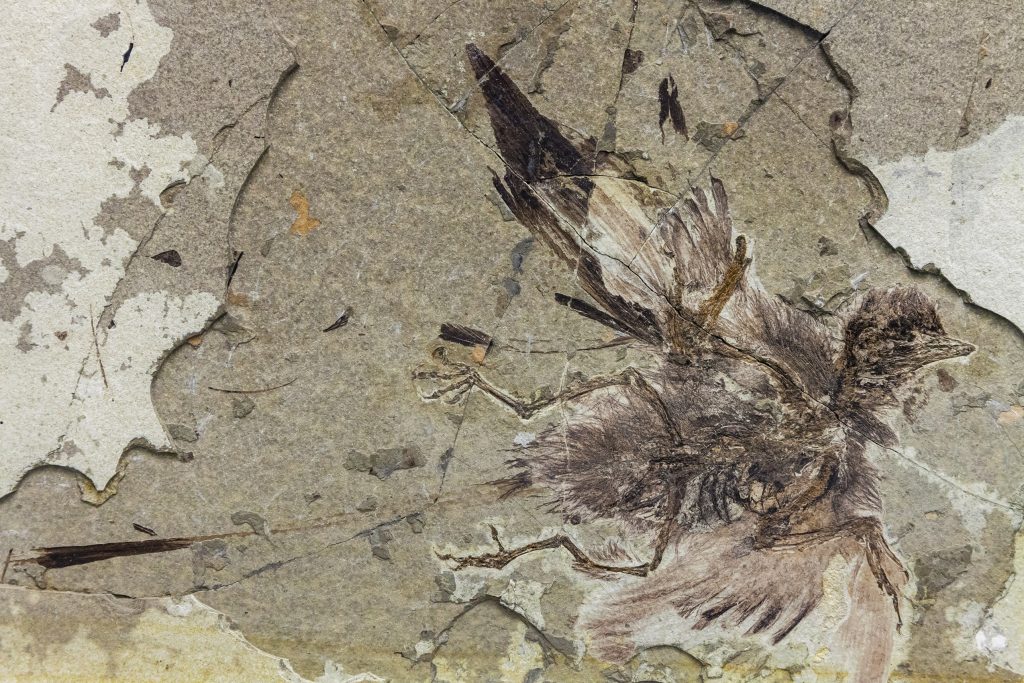
Protopteryx was a primitive bird that existed 130 million years ago. This fossil illustrates the exquisite feather detail present in many recent fossils from northern China. Tiouraren
BY RICHARD SCHNEIDER AND NICK CARTER
The origin of the avian body plan is not something bird watchers often think about. With so many species to find and identify out there, what does it matter how they originated? However, the story of bird evolution is a fascinating one, and understanding it can bring great enrichment to the hobby of birdwatching.
What Makes a Bird
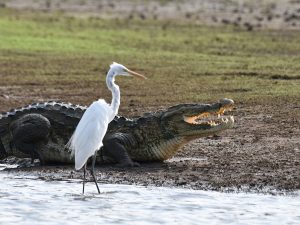
Crocodilians are the closest living relatives of birds. These two groups are the only surviving members of the Archosaurs. TIMOTHY GONSALVES
Let’s first consider the attributes that make birds unique. A key feature is the feather, which is not found in any other living animal. Though feathers look a bit like hair — indeed both are made of keratin and grow in skin follicles — they’re very different in both structure and development. In addition, birds have a distinctive skeleton featuring lightweight hollow bones, a large keel-shaped breast bone to anchor wing muscles, and a rigid airframe created through the fusion of several bones.
Most of these anatomical features are adaptations for flying. So are some of the unique organ systems of birds, including a highly efficient respiratory system. In birds, air is directed to a system of air sacs that work in combination to supply the lung with fresh air during both inspiration and expiration. This is much more efficient than our mammalian lung, which inflates and deflates with each breath, leaving behind a considerable volume of stale air with each cycle.
Let’s now rewind the clock and explore the evolutionary history of birds, paying particular attention to when and how the unique features of today’s birds were acquired. This is now one of the best understood evolutionary transitions in the history of life, thanks largely to spectacular fossil discoveries made over the past couple of decades.
Reptilian Origins
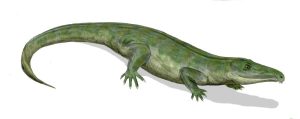
Archosaurs were the reptilian ancestors of dinosaurs. The unidirectional lung, a key feature of modern birds, arose within this group. NOBU TAMURA
We’ll begin our story with the reptilian ancestor of birds, the archosa
urs. This branch of reptiles arose just before the start of the Mesozoic Era, roughly 250 million years ago. Here we find one of the first preadaptations to flight: the unidirectional lung.2 Of course, it wasn’t used to support flight at that time, nor did it have the full complexity of the modern bird lung. Nevertheless, this is when the basic architecture of the bird respiratory system originated, marking a key point of departure from the simpler in-and-out lungs used by mammals.
Not long after the appearance of archosaurs, the Earth experienced a mass extinction event that wiped out a large proportion of all species. (This was a different extinction event than the one caused by a meteor 66 million years ago). Archosaurs survived the mass extinction, and with the ecological slate largely wiped clean, they rapidly diversified into many lineages. One of these new groups was the dinosaurs, from which birds later descended. The only other descendants of the archosaurs that survived to the present day are the crocodilians, which means that crocodiles are today the closest living relative of birds.
Birds are Dinosaurs
The early stages of dinosaur evolution saw the development of another critical preadaptation for flight: feathers.3 Recently discovered fossils indicate that feathers were present in several dinosaur lineages and possibly in their close relatives, the pterosaurs. These early feathers were not used for flying. They were single-filament structures that would have looked a bit like fur and were presumably used for insulation and display. More complex forms of feathers evolved later, particularly within the avian dinosaur lineage.
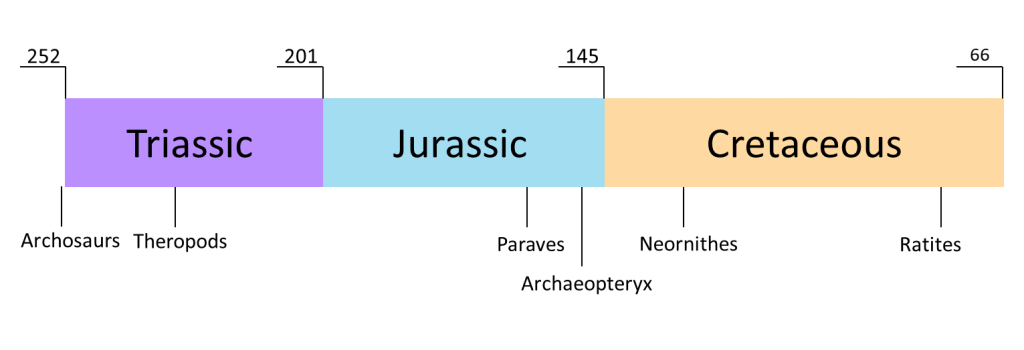
A timeline illustrating key points in the evolution of the bird body plan during the Mesozoic. The numbers along the top indicate millions of years before the present. RICHARD SCHNEIDER
The branch of dinosaurs directly ancestral to birds were the Theropods, originating around 230 million years ago. Theropods were bipedal, which was another useful preadaptation for flight in that it left the arms free to evolve into wings. Most members of this group were carnivorous. Indeed, the dominant predators for much of the Mesozoic were Theropods, including iconic dinosaurs such as Tyrannosaurus and Allosaurus.

Coelophysis was an early Theropod dinosaur that lived approximately 230 million years ago. Like most Theropods, it was a bipedal carnivore. JEFF MARTZ
As the Mesozoic Era progressed, many of the fundamental features of the avian body plan took shape within the branch of Theropods that eventually gave rise to birds.4 These features arose through stepwise transformations over millions of years. A key change was the progressive hollowing of bones, which reduced skeletal weight. Another was the fusion of the collar bones into a single wishbone (furcula), which would later be important in providing stability for flapping wings. The respiratory system became increasingly efficient, with the expansion and refinement of the air sac system. And there was progressive development of warm-bloodedness, with a higher metabolic rate.
By the mid-Jurassic, around 160 million years ago, the avian branch of Theropod dinosaurs — the Paraves — had acquired almost all the adaptations necessary for flight. However, it should be noted that none of these preadaptations evolved to support flight. Evolution does not plan ahead. Instead, each new attribute was in some way helpful to the animals that existed at the time.
Though the Paraves had acquired a large suite of preadaptations for flying, they were not yet capable of powered flight. One of the well-known families is the dromaeosaurs, or “raptors,” made famous in the Jurassic Park movies. Some early raptors were tree-dwellers that may have been capable of gliding. Microraptor of China, which bore wings on the front and hind limbs, is one of many examples. Others became larger, ground-based predators. Velociraptor from Mongolia is the most famous example, but several raptor species have also been found in Alberta.
Birds Take Flight
Some members of the Paraves were very birdlike in appearance, with small body size, crouched posture, folding wings with vaned feathers, large eyes, and braincases approaching the proportions seen in modern birds. At this point, the line between birds and dinosaurs begins to blur, forcing us to think about what we mean by the word “bird.”
By historical convention, the dividing line between reptiles and birds has long been associated with Archaeopteryx, initially discovered in Germany in 1861. Archaeopteryx possessed a curious mixture of classic bird features, such as feathers and wings, but also retained sharp claws on the hands, a long bony tail, teeth, and other reptilian characteristics. To the scientists of the day, working with a very limited fossil record, Archaeopteryx was seen as the critical “missing link” in bird evolution. Thus, Archaeopteryx was taken to be the first bird and this label has carried through to modern times. However, based on recent fossil discoveries it is now clear that no real dividing line exists between dinosaurs and birds — it’s an evolutionary continuum.5 This implies that the choice of what to label the “first” bird is largely arbitrary.
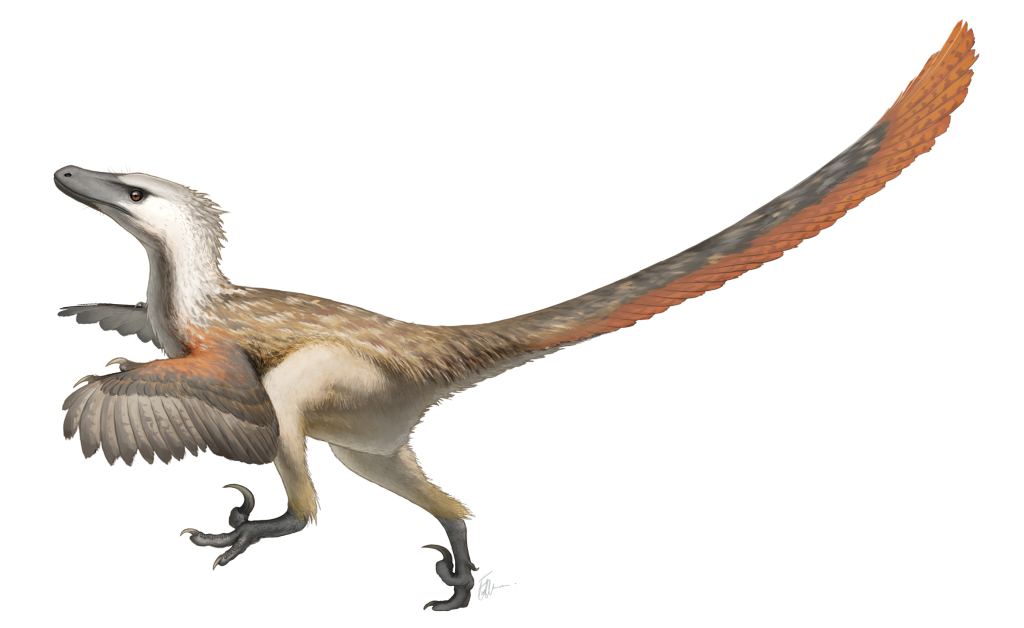
An artist’s rendition of a Velociraptor. Despite its feathers and wing-like arms, Velociraptor was a ground-based predator that could not fly. FRED WIERUM
Whether Archaeopteryx could fly, rather than glide, remains a point of debate, but recent research suggests that it could. In either case, it is around this time, 150 million years ago, that the avian branch of dinosaurs did acquire powered flight.1 By this time, all the necessary anatomical preadaptations for flight were in place, so it was mainly a matter of applying existing attributes to a new purpose. The details of this process are still being refined, but it’s clear this was not a one-off event involving a single species. Rather, this was a period of intense evolutionary experimentation involving flight that involved multiple species.
To be clear, early birds like Archaeopteryx had nowhere near the flight ability of modern birds.6 Much evolutionary tinkering was still required before the modern bird form was reached. Like an avian Model T, Archaeopteryx had all the fundamental components and was able to get from point A to B. But it was still a long way from a Ferrari.
Many of the refinements that occurred after early birds began to fly involved the perfection of muscle-driven flight.1 A key feature was the development of a keeled sternum to support large flight muscles. Another was the development of a pulley-like system involving the shoulder joint that provided more power to the upstroke when flying. The tail was reduced in size and eventually fused into a single, small, triangular bone. There was also further increase in metabolism and refinement of the respiratory system, which were needed to meet the high energy demands of flight.
Modern Birds
A treasure trove of new fossils from China show that a highly diverse avian fauna existed by the early Cretaceous, around 130 million years ago.1 This included the Neornithes group directly ancestral to modern birds as well as several other bird lineages, such as Enantiornithes, which were “cousins” to today’s birds. The Enantiornithes were in fact the most abundant, widespread, and diverse bird group during this period. However, all members of the Enantiornithes went extinct during the mass extinction that marked the end of the Cretaceous (66 million years ago), leaving no representatives among today’s birds.
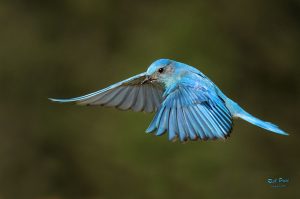
Modern birds are the only lineage of dinosaurs to survive the Cretaceous mass extinction. RICK PRICE
The differentiation of the Neornithes into the major orders of modern birds began in the late Cretaceous. The first to branch off were the ratites, represented today by birds such as ostriches and rheas. Next was the fowl group (Galloanseres), including both waterfowl and landfowl. The evolutionary branching of the remaining bird orders is complex and has not been fully worked out.
The mass extinction event at the end of the Cretaceous caused by a meteor impact was an important driver of bird evolution. This event served as a filter, weeding out many early bird lineages and killing off all other dinosaurs. Exactly why certain bird lineages survived and others did not remains unclear.
With many ecological niches available to exploit after the mass extinction, the surviving bird lineages underwent another evolutionary radiation, producing many new forms. But these new forms were simply variations and refinements of the basic bird body plan, completed in the mid-Cretaceous with the last common ancestor of all living birds (i.e., the Neornithes). Attributes arising after this last common ancestor are not found in all birds and so are not foundational. What makes matters confusing is that many attributes of modern birds arose independently within different bird orders, in a process called convergent evolution. For example, swallows and swifts look very similar, but swallows are a type of songbird whereas swifts are related to hummingbirds. More generally, adaptations for specific lifestyles (e.g., nocturnal, raptorial, pelagic) have evolved multiple times.
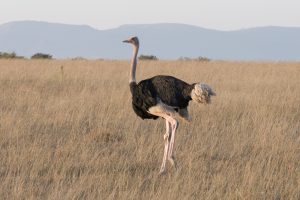
Birds evolved into many unique forms following their origin as a distinct lineage 150 million years ago. The first to branch off were the ratites, of which ostriches are a modern example. PAUL HOWZEY
In summary, the avian body plan was pieced together over 250 million years of evolution rather than in one burst of innovation. Many key attributes — including the unidirectional lung, feathers, warm-bloodedness, and lightweight bipedal skeleton — evolved at an early stage of evolution for reasons that had nothing to do with flight. But once these preadaptations were in place, they became a winning platform that not only allowed dinosaurs to fly under their own power, but to survive the late Cretaceous extinction event and become the Earth’s most diverse terrestrial vertebrate, with over 10,000 species.
The story of birds is complex yet fascinating and we are fortunate to live in a time when new discoveries are always around the corner. The next time you see a chickadee at your bird feeder, consider that you are looking at a type of dinosaur — an intriguing thought. They’ve survived a lot since the Cretaceous, and now we must think and act accordingly so that the species we have left will continue to thrive.
Richard Schneider is a conservation biologist who has worked on species at risk and land-use planning in Alberta for the past 30 years. He currently serves as the Executive Director of Nature Alberta.
Nick Carter is a writer, photographer, and naturalist from Edmonton. From birds and bugs to flowers and fossils, Nick is always seeking out the natural wonders of this province and sharing his enthusiasm with others.
This article originally ran in Nature Alberta Magazine – Fall 2023.
